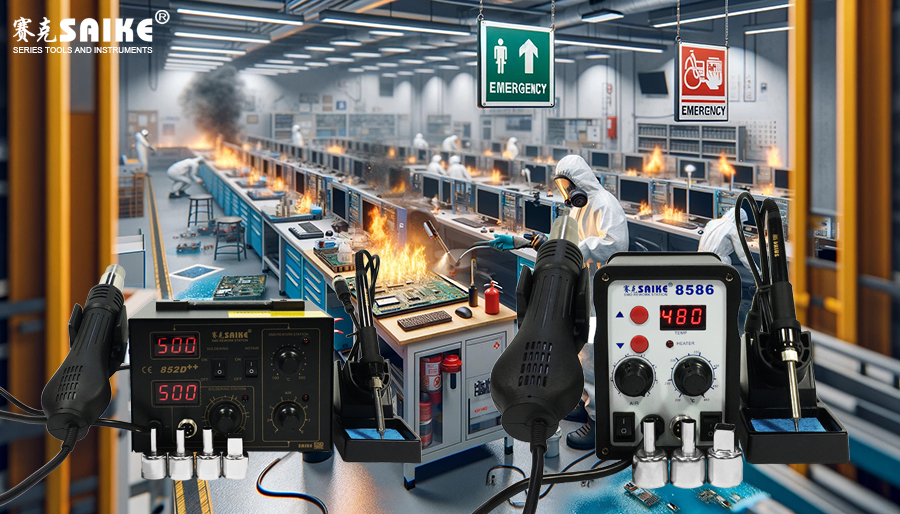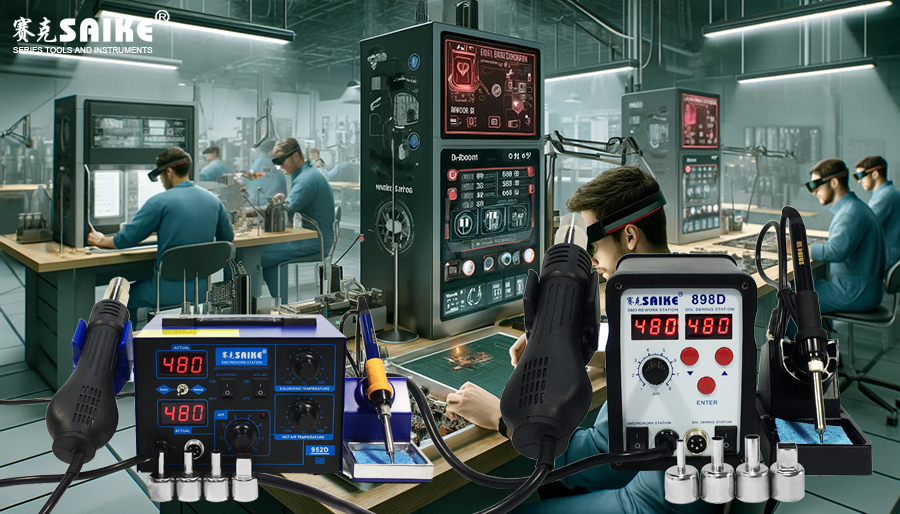
SK-YJ000RFCHT-KP 100012
Hot air rework stations play a crucial role in electronic manufacturing and repair work, but emergencies such as equipment failures, operator injuries, or chemical spills may occur during operation. To ensure a safe working environment and reduce potential risks, this article provides a series of emergency response guides and measures for possible contingencies arising from the use of hot air rework stations.
I. Emergency Handling of Equipment Failures
1.Sudden Equipment Shutdown:
– Immediately cut off the power: Use the equipment switch or cut off the power supply to prevent short circuits within the equipment.
– Check the power cord and plug: Confirm whether the equipment has stopped working due to a damaged power cord or loose plug.
– Contact a repair expert: If the problem is not resolved after preliminary inspection, contact professional technicians for maintenance.
2.Equipment Overheating:
– Immediately cut off the power: Avoid the risk of fire caused by prolonged overheating of the equipment.
– Cool the equipment: Under safe conditions, allow the equipment to cool naturally. Do not use water to cool it directly to prevent damage to electrical components.
II. Emergency Handling of Operator Injuries
1.Hot Air Burns:
– Immediately cool the wound with cold water: Cool continuously for at least 10 minutes to reduce the risk of more severe injuries caused by heat penetrating deep into the skin.
– Cover the wound: Use a clean, dry, sterile dressing to cover the wound.
– Seek medical help: Depending on the severity of the injury, seek medical attention or call emergency services promptly.
2.Eye Irritation from Chemicals:
– Immediately rinse the eyes: Use an eyewash station or clean water source to rinse the eyes for at least 15 minutes without rubbing them.
– Avoid covering the injured eye: Do not touch the eyes with contaminated hands or cloth.
– Seek professional ophthalmological medical help: Seek medical attention immediately after rinsing and provide details about the type of chemical exposure.
III. Emergency Handling of Chemical Spills
1.Small-scale Spills:
– Wear appropriate personal protective equipment: Such as chemical-resistant gloves, protective glasses, and a mask.
– Control the source of the spill: If safe and feasible, seal or block the spill source.
– Ventilation: Ensure good ventilation in the work area, using exhaust fans or opening windows.
2.Large-scale Spills:
– Immediate evacuation: Notify all personnel to leave the spill area and prevent unauthorized access.
– Alarm: Immediately notify plant security personnel or local emergency management authorities.
– Professional cleanup: Have a professional team perform chemical cleanup and disinfection.
IV. Emergency Handling of Fires
1.Discovering Initial Fires:
– Use a fire extinguisher: If the fire is small, use a CO2 or dry powder fire extinguisher for initial suppression.
– Evacuate and call the fire department: If the fire is uncontrollable, immediately evacuate all personnel and dial the fire department.
2.Self-protection in case of fire:
– Maintain a low posture: Try to keep a low posture to avoid inhaling smoke.
– Cover your nose and mouth with a wet cloth: If you must cross a smoky area, cover your nose and mouth with a wet cloth.
V. Conclusion
Facing possible emergencies during the operation of hot air rework stations, taking correct emergency measures is crucial. Developing an emergency plan beforehand and conducting regular safety training can significantly reduce the risk of accidents, ensuring operator safety and production continuity. Remaining calm and quickly adopting scientific and reasonable measures in any emergency is the key to ensuring safety.


